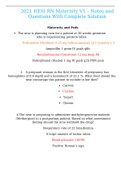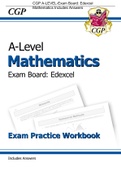-
1. Tentamen (uitwerkingen) - Phtls study guide exam questions with complete solutions graded a+
-
2. Tentamen (uitwerkingen) - New phtls (pre) exam questions and complete solutions graded a+
-
3. Tentamen (uitwerkingen) - Phtls trauma assessment and hemorrhage exam questions and complete solutions graded a...
-
4. Tentamen (uitwerkingen) - Phtls post exam questions and complete solutions graded a+
-
5. Tentamen (uitwerkingen) - Phtls - post test, 8th edition exam questions with complete solutions graded a+
-
6. Tentamen (uitwerkingen) - Phtls exam questions and certified solutions graded a+
-
7. Tentamen (uitwerkingen) - Phtls pre-test questions with correct solutions graded a+
-
8. Tentamen (uitwerkingen) - Phtls naemt 11 exam questions and complete solutions graded a+
-
9. Tentamen (uitwerkingen) - Phtls test questions with certified solutions graded a+
-
10. Tentamen (uitwerkingen) - Phtls quiz questions with complete answers graded a+
-
11. Tentamen (uitwerkingen) - Tccc unit 1 exam questions and complete solutions graded a+
-
12. Tentamen (uitwerkingen) - Trauma surgery - chapter 28 - sfa202 rxam questions and complete solutions graded a+
-
13. Tentamen (uitwerkingen) - Sccems exam questions and complete solutions graded a+.
-
14. Tentamen (uitwerkingen) - Emergency trauma exam questions and complete solutions graded a+.
-
15. Tentamen (uitwerkingen) - Emt - chapter 36 exam questions and complete solutions graded a+
-
16. Tentamen (uitwerkingen) - Phtls quiz questions with complete solutions graded a+
-
17. Tentamen (uitwerkingen) - Phtls - thoracic trauma (ch12), phtls pretest, phtls pre test 8th edition, phtls 8th ...
-
18. Tentamen (uitwerkingen) - Prehospital care 10th edition chapter 40 exam questions and complete solutions graded...
-
19. Tentamen (uitwerkingen) - Phtls block exam questions and complete solutions graded a+
-
20. Tentamen (uitwerkingen) - Lecture 14 multisystem trauma exam questions and complete solutions graded a+
-
21. Tentamen (uitwerkingen) - Pre hospital care exam questions and complete solutions graded a+
-
22. Tentamen (uitwerkingen) - Prehospital trauma care exam questions and complete solutions graded a+
-
23. Tentamen (uitwerkingen) - Phtls quiz questions and complete solutions graded a+
-
24. Tentamen (uitwerkingen) - Phtls test questions with complete solutions graded a+
-
25. Tentamen (uitwerkingen) - Phtls test questions and correct solutions graded a+
-
26. Tentamen (uitwerkingen) - Phtls exam questions and complete answers graded a+
-
27. Tentamen (uitwerkingen) - Phtls test questions and complete answers graded a+
-
28. Tentamen (uitwerkingen) - Phtls review 2024 exam questions and complete solutions graded a+.
-
29. Tentamen (uitwerkingen) - Phtls 10th edition exam questions and complete solutions graded a+
-
30. Tentamen (uitwerkingen) - Phtls pre test 2024 questions and complete solutions graded a+
-
31. Tentamen (uitwerkingen) - Phtls exam questions and complete rationales graded a+
-
32. Tentamen (uitwerkingen) - Phtls review exam questions with complete answers graded a+.
-
33. Tentamen (uitwerkingen) - Phtls capt. 2020 steps, orders, & charts exam questions and complete solutions graded...
-
34. Tentamen (uitwerkingen) - Phtls and trauma review exam questions and complete solutions graded a+
-
35. Tentamen (uitwerkingen) - Phtls pretest questions and complete solutions graded a+
-
36. Tentamen (uitwerkingen) - Phtls test questions and complete solutions graded a+
-
37. Tentamen (uitwerkingen) - Phtls exam questions and complete solutions graded a+
-
38. Tentamen (uitwerkingen) - Phtls study guide exam questions and complete solutions graded a+
-
39. Tentamen (uitwerkingen) - Phtls exam study guide questions and complete solutions graded a+
-
40. Tentamen (uitwerkingen) - Phtls review exam questions and complete solutions graded a+
-
41. Tentamen (uitwerkingen) - Phtls - post test, 8th edition exam questions and complete solutions graded a+
-
42. Tentamen (uitwerkingen) - Phtls final exam questions and complete solutions graded a+
-
43. Tentamen (uitwerkingen) - Phtls 9th ed. self-test questions and complete solutions graded a+
-
44. Tentamen (uitwerkingen) - Phtls pre & post test questions and complete solutions graded a+
-
Meer zien






